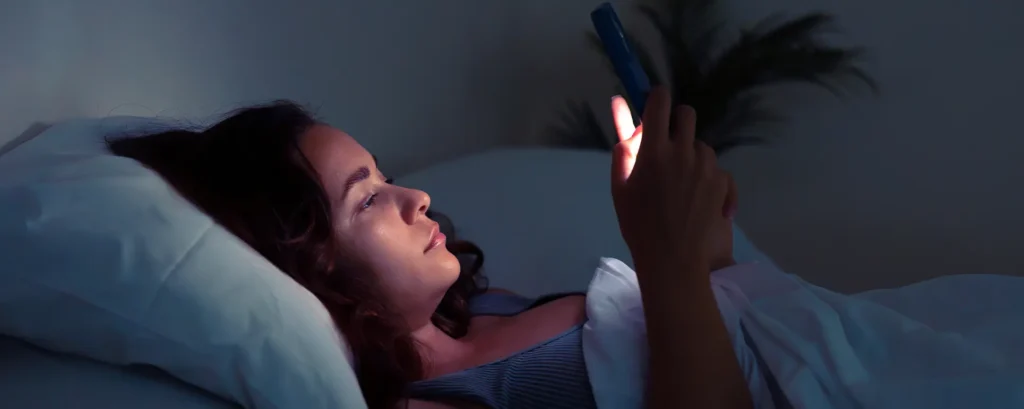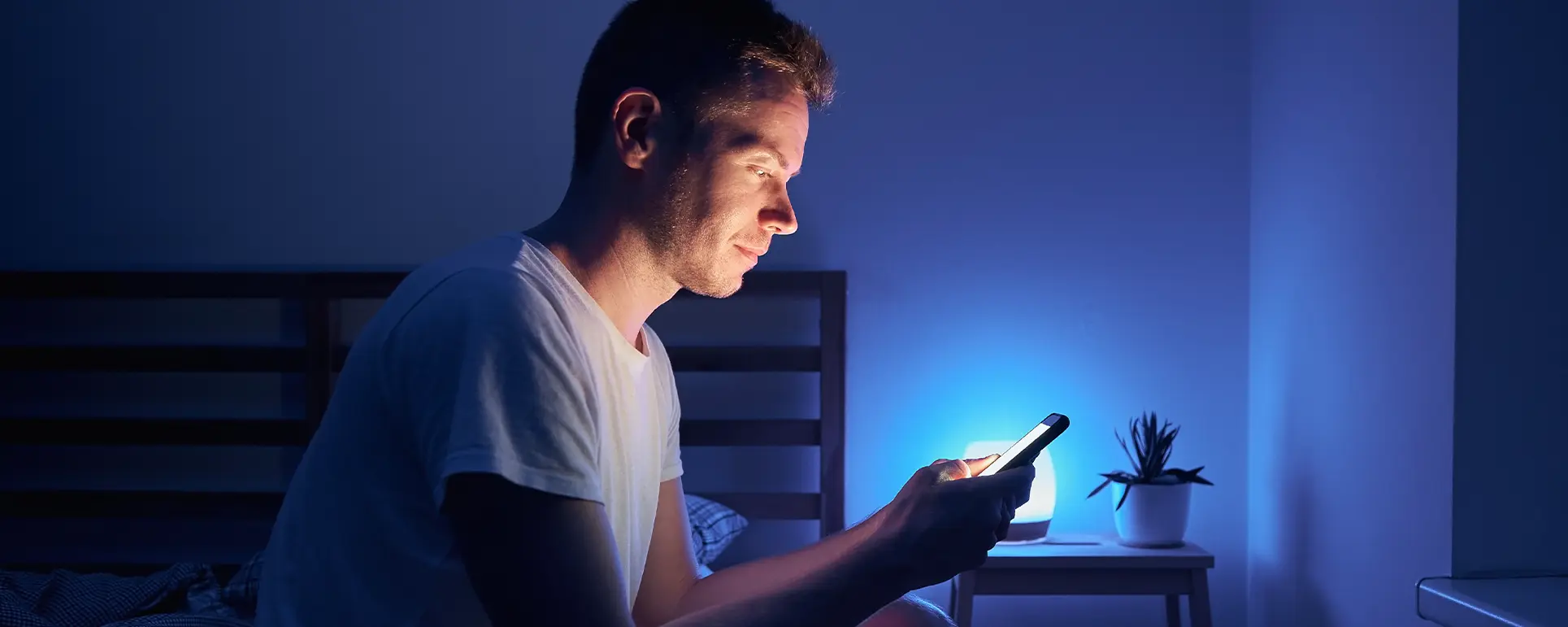In today’s digital-first world, most of us spend a significant part of our day in front of screens. Whether it’s scrolling through social media on our phones, working long hours on a laptop, binge-watching shows, or even sitting under artificial LED lights, exposure to digital devices has become a routine part of modern life. Alongside this surge in screen time, concerns have emerged about the impact of blue light also known as high-energy visible (HEV) light on our overall health, particularly our skin.
Unlike ultraviolet (UV) rays from the sun, which have long been linked to sunburn, premature ageing, and skin cancer, the effects of blue light are still relatively new to science. However, the conversation is growing louder. Many people now wonder: could hours spent in front of screens be accelerating the appearance of fine lines, causing stubborn pigmentation patches, or weakening the skin barrier over time? These are valid concerns, especially as our reliance on technology continues to rise.
Research suggests that blue light can penetrate the skin more deeply than UVA rays, reaching into the dermis where collagen and elastin the building blocks of firm, youthful skin are found. This has led some dermatologists to investigate whether prolonged exposure may contribute to oxidative stress, an imbalance that damages skin cells and leads to inflammation and visible ageing. While the intensity of blue light from digital devices is far lower than what we receive from sunlight, the duration of exposure is much higher, with many of us spending 8 to 12 hours a day in front of a screen.
So, is blue light from screens truly harmful, or are these fears exaggerated compared to the well-established dangers of UV radiation and pollution? The answer isn’t simple. While more studies are needed to measure the long-term effects, early findings indicate that skin exposed to blue light shows changes in pigmentation, increased redness, and slower recovery from damage. This has been enough for skincare experts to recommend taking a cautious approach.
The good news is that there are practical steps you can take to protect your skin without having to cut back dramatically on your digital lifestyle. From using antioxidant-rich skincare and tinted sunscreens to adjusting screen settings and limiting late-night device use, simple changes can reduce potential risks. Understanding the science and staying informed will help you separate myths from facts and make confident choices about your skin health.
1. What Is Blue Light?

Blue light is part of the visible light spectrum, which ranges from red to violet. Within this spectrum, blue light has a wavelength of approximately 380–500 nanometres, making it one of the shortest and most energetic types of visible light. Because of its higher energy and shorter wavelength, blue light can penetrate further into the skin than UVA and UVB rays, reaching the deeper layers where collagen and elastin fibres are located. This is why researchers have begun examining its potential long-term impact on skin health.
It’s important to clarify that blue light is not inherently “bad.” In fact, some exposure is beneficial. Natural blue light from the sun plays an essential role in regulating the body’s circadian rhythm the internal clock that tells us when to be awake and when to sleep. It also contributes to mental alertness, helps boost mood, and is even used in medical therapies, such as blue light treatment for acne. The challenge comes with prolonged and repeated exposure, especially from artificial sources, where the balance between benefits and drawbacks becomes more complex.
When people hear “blue light,” the first thought is often of digital devices smartphones, tablets, laptops, and televisions. While these gadgets do emit blue light, studies show that the intensity is far lower than what we get from sunlight. For instance, a short outdoor walk in the sun exposes the skin to far more blue light than several hours spent in front of a computer screen. However, the concern with devices is the cumulative effect: most of us now spend 8–12 hours a day in front of screens, which creates prolonged, close-range exposure. This has raised questions about whether such habits could accelerate visible skin changes, particularly in the form of pigmentation and premature ageing.
Apart from digital screens, there are other everyday sources of blue light that often go overlooked. Artificial lighting, such as LED bulbs and fluorescent lamps, also emit blue light. While energy-efficient and cost-effective, these modern lighting solutions contribute to low-level exposure throughout the day, especially in office and indoor environments where natural sunlight is limited.
That said, the sun remains the dominant source of blue light exposure, accounting for the vast majority of what our skin and eyes encounter daily. In fact, outdoor exposure during daylight hours overwhelms any amount received from digital screens. This doesn’t mean screen-based exposure is irrelevant it just means that the conversation around blue light needs to take both natural and artificial sources into account.
To summarise, the most common sources of blue light include:
- Digital devices: phones, tablets, laptops, desktop computers, televisions, and e-readers.
- Artificial lighting: LED bulbs, fluorescent lights, and other energy-efficient lamps.
- Sunlight: the most powerful and unavoidable source of blue light.
While blue light is unavoidable in modern life, understanding its sources and potential effects is the first step towards making informed choices about skin protection and overall health. By recognising that it’s not just about our phones but also about sunlight and indoor lighting, we can take a more balanced approach to prevention and care.
2. Potential Skin Effects

Research into the effects of blue light on skin is still relatively new, but interest in the subject has grown rapidly as screen time has become a central part of modern living. While scientists agree that blue light from devices is nowhere near as harmful as UV radiation from the sun, early findings suggest that it may still have subtle but noticeable effects on the skin, particularly with long-term, repeated exposure.
Here are some of the most commonly discussed ways blue light may impact skin health:
1. Pigmentation changes
One of the strongest links found so far between blue light and skin health is pigmentation. Blue light exposure has been shown to generate oxidative stress a process where unstable molecules called free radicals damage healthy cells. This stress can stimulate melanocytes, the pigment-producing cells in the skin, leading to increased melanin production. The result is dark spots, uneven skin tone, or a worsening of existing hyperpigmentation.
Interestingly, research suggests that these pigmentation changes are more pronounced in darker skin types (Fitzpatrick skin types III to VI). While all skin tones may be affected, people with medium to deep complexions may notice more visible or stubborn pigmentation changes from repeated exposure.
2. Collagen damage
Collagen is the protein that gives skin its structure, firmness, and youthful appearance. Laboratory studies indicate that blue light can interfere with fibroblasts the cells responsible for producing collagen and elastin. Over time, this could weaken the skin’s support structure, leading to a gradual increase in fine lines, wrinkles, and sagging. While the impact is not nearly as dramatic as UV-induced photoageing, the concern is that constant, low-level exposure from devices may add to the cumulative effects of sun and pollution, accelerating skin ageing in subtle ways.
3. Inflammation and redness
Another potential outcome of blue light exposure is skin inflammation. Prolonged exposure has been linked to an increase in reactive oxygen species (ROS), which can trigger an inflammatory response. For people with sensitive skin, rosacea, or eczema, this can mean flare-ups of redness, irritation, or dryness. Though these effects are generally mild compared to UV damage, they may still be significant for individuals with pre-existing skin conditions or compromised skin barriers.
4. Slower skin recovery
Some studies also suggest that blue light exposure may slow down the skin’s ability to recover from stress or damage. For example, wounds or acne lesions may take slightly longer to heal when skin cells are exposed to excess HEV light, as the oxidative stress disrupts normal cellular repair processes.
It’s important to remember that while these potential effects are concerning, the intensity of blue light from screens is much lower than from sunlight. The biggest question researchers are trying to answer is whether long-term, daily screen exposure adds up in a meaningful way. Dermatologists generally agree that more data is needed, but many now recommend simple protective measures such as antioxidants, tinted sunscreens, and limiting late-night device use especially for those already prone to pigmentation or sensitivity.
3. Dermatologists’ Perspective

Whenever the topic of blue light and skin comes up, dermatologists encourage people to take a step back and look at the bigger picture. Yes, blue light from screens is real, and yes, it has been shown in studies to trigger oxidative stress and potentially influence pigmentation. But in terms of intensity, the blue light coming from your phone or laptop is tiny compared to what you’re exposed to every single time you step outside in daylight. The sun remains the dominant source of both UV and visible light exposure, and it is still the leading cause of skin ageing and damage.
That’s why most experts stress that you shouldn’t lose sleep worrying about the hours you spend on your devices at least not from a skin perspective. Instead, the focus should always remain on UV protection, which has decades of research proving its harmful effects. That said, many dermatologists agree that since blue light research is evolving, it makes sense to add a few simple protective habits into your routine, especially if you spend long hours in front of screens or if you’re prone to pigmentation.
Here’s the kind of advice dermatologists usually give their patients:
1. Sunscreen is still non-negotiable
The number one thing dermatologists emphasise is that daily sunscreen use should always come first. A broad-spectrum sunscreen protects against UVA and UVB rays, which are far more damaging than screen-based blue light. If you only have time for one skincare step in the morning, make it sunscreen. This single habit will protect your skin from wrinkles, sagging, sunspots, and even skin cancer far more effectively than anything else.
2. Think beyond traditional sunscreen
Some sunscreens do more than just block UV. Tinted sunscreens, for example, often contain iron oxides that provide added protection against visible light, including blue light. These are particularly helpful for people who struggle with stubborn pigmentation, such as melasma. Similarly, mineral sunscreens with ingredients like zinc oxide or titanium dioxide work by physically scattering light away from the skin, which can also reduce blue light penetration.
3. Add antioxidants into your skincare
Another practical step dermatologists recommend is incorporating antioxidants into your routine. Blue light, like pollution and UV, can create free radicals that damage skin cells. Antioxidants such as vitamin C, niacinamide, vitamin E, and green tea extract help neutralise these free radicals and keep the skin looking healthier. Regular use can improve brightness, reduce uneven tone, and add an extra layer of defence against daily stressors.
4. Be mindful of your screen habits
Protecting your skin isn’t just about what you apply it’s also about how you use your devices. Dermatologists often advise patients to take regular breaks from screens, not only to give the eyes a rest but also to reduce prolonged exposure of the face to blue light. Simple steps like enabling “night mode” on your phone or reducing screen brightness in the evenings can also help. These habits won’t just benefit your skin, but your sleep and overall wellbeing too.
5. Keep perspective
Perhaps the most reassuring message from dermatologists is that blue light isn’t the biggest enemy your skin faces. While research shows it can play a role in pigmentation and subtle ageing, it doesn’t compare to the proven, long-term harm caused by UV rays. As long as you are consistent with sun protection, maintain a balanced skincare routine, and use antioxidant-rich products, you are already taking the most effective steps to protect your skin.
4. Practical Protective Steps
While the risk of skin damage from blue light is considered low compared to UV rays, taking a few preventative measures can give your skin an extra layer of protection and peace of mind. These habits don’t require drastic changes, but when followed consistently, they can help maintain healthier, more resilient skin over time.
- Apply a daily SPF, even indoors. Many people assume sunscreen is only needed outdoors, but blue light can penetrate through glass. If you spend hours near a window or step outside during the day, applying a broad-spectrum sunscreen every morning is a smart move. Look for formulas with added antioxidants, as they offer enhanced defence against oxidative stress.
- Incorporate antioxidants into your skincare. Blue light can increase the production of free radicals, which may accelerate skin ageing. Ingredients such as vitamin C, niacinamide, resveratrol, and green tea extract are proven to counteract oxidative damage. Using an antioxidant serum in your morning routine, followed by SPF, is one of the most effective ways to fortify your skin’s natural shield.
- Use screen filters or blue light glasses. If you work long hours on a computer or phone, protective tools can make a difference. Blue light filters for screens or specially designed glasses reduce the intensity of light hitting your eyes and skin. Aside from supporting skin health, they can also ease digital fatigue, headaches, and eye strain.
- Support your skin from within. External care is important, but your skin also benefits greatly from internal support. Staying hydrated keeps your skin barrier strong, while eating foods rich in antioxidants and healthy fats provides nourishment at a cellular level. Prioritising good sleep allows the body to repair itself, making your skin more resilient to environmental stressors, including light exposure.
- Take regular screen breaks. Beyond products and skincare, simple lifestyle changes help too. Following the 20-20-20 rule looking at something 20 feet away for 20 seconds every 20 minutes reduces not only eye strain but also unnecessary prolonged exposure to blue light.
By combining protective skincare, healthy lifestyle choices, and smart screen habits, you can easily reduce the impact of blue light while giving your skin the best possible support.
Final Thought: Should You Really Worry About Blue Light?
The idea that screen time alone can cause serious skin damage is often overstated. While blue light does have some effects, its impact is far smaller than that of UV rays from the sun. By sticking to daily sun protection, incorporating antioxidants into your skincare, and practising healthy lifestyle habits, you can minimise any potential risks without overhauling your routine.
If you remain concerned about pigmentation, premature ageing, or skin sensitivity, it’s always worth getting professional guidance tailored to your skin type. You can get in touch with us to book a consultation with one of our expert dermatologists in London, or personalised advice and treatment options.
References:
- Duteil, L. A., Queille-Roussel, C., Maubert, Y., Marchesini, R., Bruno, R., Bertin, C. & Ortonne, J. P., 2021. Blue light in dermatology: effects on pigmentation and therapeutic applications. Dermatology and Therapy, 11(2), pp. 1–15. https://doi.org/10.1007/s13555-021-00530-x
- Suitthimeathegorn, O., Yang, C., Ma, Y. & Liu, W., 2022. Direct and indirect effects of blue light exposure on skin: a review of published literature. Skin Pharmacology and Physiology, 35(4), pp. 305–318. Available at: https://pubmed.ncbi.nlm.nih.gov/36044837/
- Kleinpenning, M. M. J., Smits, T., Frunt, M. H. A., van Erp, P. E. J., van de Kerkhof, P. C. M. & Gerritsen, R. M. J. P., 2010. Clinical and histological effects of blue light on normal skin. Journal of Investigative Dermatology, 130(1), pp. 259–261. Available at: https://pubmed.ncbi.nlm.nih.gov/19675549/
- Walters, N. J., Nogueira Teixeira, D., Lam, J. & Lim, H. W., 2023. The impact of blue light and digital screens on the skin. Journal of Cosmetic Dermatology, 22(4), pp. 1050–1061. Available at: https://pubmed.ncbi.nlm.nih.gov/36946907/
- Ianiello, C., Carpi, S. & Romanelli, M., 2024. Deciphering the effects of different types of sunlight radiation on skin function: a review. Cosmetics, 11(3), 80. Available at: https://www.mdpi.com/2079-9284/11/3/80
